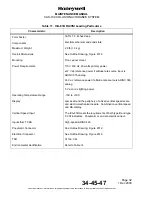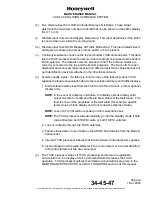
Page 40
1 Dec 2003
34-45-4
7
MAINTENANCE MANUAL
CAS-100 COLLISION AVOIDANCE SYSTEM
Use or disclosure of information on this page is subject to the restrictions in the proprietary notice of this document.
(d) Own aircraft identification (ID) code (transponder ID) received on the ARINC 429
data bus from own Mode S transponder. Own aircraft identification is input to the
transponder through 24 discrete bit strapped inputs. Own aircraft identification is
used by the TCAS processor during air-to-air coordination procedures.
(e) Own aircraft maximum airspeed data received on the ARINC 429 data bus from
own Mode S transponder. Own aircraft maximum airspeed is input to the
transponder through three discrete bit strapped inputs. This data is used in the
maximum closing rate projections and RA computations.
(f)
Antenna delay strap input. These 3 discrete input are used during TCAS range
computations to adjust for the cable delay differences between the top and the
bottom antennas.
(g) Performance limit input. These inputs are used as factors in RA computations. The
performance limit inputs include:
1 Performance limit discrete input or ARINC 429 input from performance
management computer.
2 Five discrete altitude limit program strap inputs (2000, 4000, 8000, 16000, and
32000).
3 Four discrete 1500 fpm Climb Inhibit inputs which are configured by the user to
limit the RAs to performance functions of the aircraft. (Example: Wing flap
retracted/extended switch can be connected to these input or the Increased
Climb Inhibit input depending on the properties of the aircraft.)
4 Four discrete 2500 fpm Increased Climb Inhibit input which are configured by the
user to limit RAs to performance functions of aircraft.
NOTE:
Although not specifically a part of performance limits, the discrete
input
from the landing gear retracted/extended switch can be for performance
limit input shown in paragraphs 4 and 5 above. But, this input is for other
functions, for example making a bottom directional antenna operate as an
omni antenna in gear-down conditions.
(h) Discrete input from weight-on-gear (Air-Ground) strut switch. Tells TCAS if own
aircraft is in-flight or on-the-ground.
(i)
Advisory Delay discrete input from ground proximity and wind shear system (if
applicable).
(j)
Discrete input from optional Advisory Cancel switch.















































